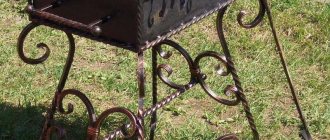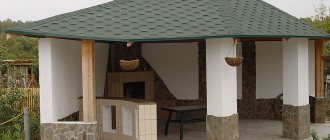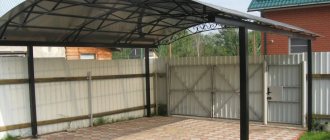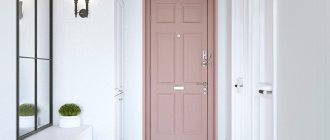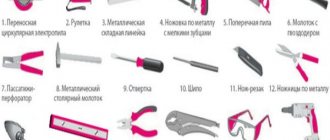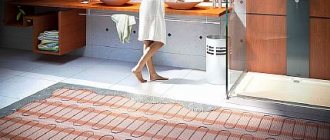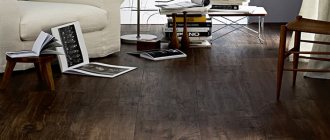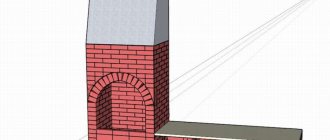Light Italian pergolas look romantic, but our people are closer to practical and comfortable gazebos in which you can fry meat and relax, and for this you need a major grill with a chimney. Let's look at the pros, cons and performance characteristics of classic barbecues, plus you will receive drawings and a step-by-step plan for constructing such structures with your own hands.
In the Russian climate, lightweight pergolas with a lattice roof are not popular.
A pergola is a lightweight canopy with an open lattice roof. Such gazebos may have walls, but they are also made of lightweight trellises and act as a base for climbing plants.
Why build a chimney in a light gazebo
From the point of view of the lazy layman, there is no point in arranging a chimney for an outdoor open shed, because there is no room as such, there is only a roof with lattice walls, and if the wind blows in the opposite direction, then you can get by with a collapsible barbecue.
The key word here is “if,” experienced summer residents know that as soon as you light a fire and start frying meat, according to the “law of meanness,” all the smoke will go to the table. And in a protected barbecue with a chimney, according to the laws of physics, warm air, and accordingly, smoke must go into the chimney.
Without a smoke eliminator, soot will settle on the ceiling of the gazebo.
In addition, without a smoke eliminator, after the second use of the barbecue, the ceiling in the gazebo will be covered with a layer of soot, and it is impossible to clean it off. Plus, the more you cook, the more intensely this soot will fall on your head. In addition, there is a high risk of fire.
How to make a barbecue hood with your own hands.
Before starting work, measure your grill; if your dimensions differ, then you need to adjust the dimensions of the hood.
Before work, new metal corners must be cleaned from factory grease with a clean rag. We use a grinder to cut metal corners (dimensions for each part of the grill are in the drawings below). To avoid metal shavings when cutting metal, be sure to wear safety glasses.
- We weld 2 sides of the hood base from metal corners:
- Then we weld the corners to them for the back surface of the grill base:
- Assembling the lower part of the dome of the exhaust hood for the barbecue:
- We weld the corners of the back of the barbecue dome onto it:
- Assembling the side parts of the barbecue hood dome:
- Assembling the pipe:
- After welding, we process the seams of the hood with a grinding disc. In order to protect the metal, we treat the frame with heat-resistant paint.
- We mark the metal for covering the exhaust hood:
- We bend the edges and fold lines, securing the sheet to the edge of the workbench:
- We cover the base of the hood with metal using rivets and an installation tool (rivet gun):
- Before covering the hood dome, we add a metal plate diagonally inside, which will help improve draft. This plate is a metal sheet measuring 99x34 cm with 2 cm edges on the edges, to which it is attached to the bottom of the dome.
- We mark and cut out the metal for lining the hood dome:
- We cover the pipe of the exhaust hood for the barbecue:
- We paint the grill hood with thermal paint.
- We install the base on the grill, securing it to the brick with self-tapping screws for concrete (brick).
- We install the dome, securing it with rivets to the edge of the base.
- We install the pipe, putting it on the dome, using rivets for fastening.
Types of smoke exhaust structures
We’ve sorted out the purpose, now let’s talk about the types of chimneys and the materials from which they are made. The choice here is small; in both closed and open gazebos, hoods are either metal or brick.
Nowadays they still sell branded stationary barbecues made of fireproof plates that fold up like a construction set. The thing is convenient, but the price is high and since in this case we are talking about home-made structures, these braziers are not of interest to us.
Branded structures made from fire-resistant plates are assembled quickly, but are expensive.
Metal chimneys
An iron hood is much lighter than a brick one, so it can be installed in any gazebo. Here you do not need a capital foundation and mason skills, the main thing is that the roof rafter system can withstand an additional 50-70 kg.
In addition to light weight, metal structures have a number of advantages:
- Any home craftsman can make such a lampshade with a pipe with his own hands. Moreover, even if you don’t have a welding machine, you can assemble the structure with bolts, but more on that later;
- There are models of smoke extractors that provide the option of adjusting the position of the lampshade in height; making them with your own hands is a little more difficult, but still possible;
There are models of smoke extractors with height adjustment.
- It is extremely simple to maintain and care for such a structure, because soot from smooth metal can be removed with a stiff brush in 15 minutes;
- If the gazebo is small, then you can easily get by with a prefabricated metal barbecue, which is installed under the mounted smoke extractor only during cooking, and then removed, thereby freeing up space;
- Any metal structure can be disassembled, which means it is possible to move it to another gazebo.
A portable barbecue is suitable for a hanging smoke extractor.
If you choose the right metal and correctly assemble the chimney, then such structures have no significant disadvantages. A high-quality iron chimney will last as long as the gazebo itself.
If the lower edge of the hanging smoke extractor is located at a distance of more than half a meter from the edge of the barbecue, then it is advisable to equip the pipe with forced exhaust ventilation.
A high-temperature smoke fan will solve the problem of draft in the chimney.
Brick chimneys
Of course, you will have to tinker with the construction of a brick structure, but this structure has its significant advantages:
- A solid covered brick chimney, provided it is laid correctly, is guaranteed to provide good draft; such a barbecue will no longer smoke;
- If you take a beautiful facing brick, then an ordinary barbecue will turn into a work of art;
- Brick structures, of course, take longer to heat up, but they accumulate heat, which is very important in the cooking process;
- In such barbecues, only the front part is open, the other 3 sides are closed. If you install metal doors on the facade, the grill automatically turns into an oven or smokehouse;
- The brickwork is not afraid of any vagaries of the weather and does not rust, so it does not need maintenance, and even if some crack appears, it can easily be sealed with a special heat-resistant putty;
- A brick structure protected by a gazebo roof can last at least 25 years, although in some dachas there are brick barbecues built half a century ago.
Brick structures are very durable.
There are only 3 significant disadvantages of such structures:
- The structure is heavy and a reinforced cast foundation will have to be installed under it;
- Bricklaying requires a certain skill , but believe me, mastering this science is not so difficult, especially since a barbecue is not a house and perfect masonry is not necessary there;
- Opponents point to the high cost , but here the issue is moot; a smoke extractor made of good thick stainless steel or copper with an insulated sandwich pipe is unlikely to cost less than several dozen bricks with mortar.
- Fireplace in the gazebo
A few words about folding barbecues
In my opinion, folding barbecues are a good, but still temporary option. Initially, they were intended for forays into nature, and in gazebos the use of such structures is justified only from the point of view of saving space.
Indeed, a hanging box with a smoke exhauster will solve the problem of smoke and soot, but there are more disadvantages here. Let's start with the fact that the metal in such structures is thin and wears out over time, so collapsible braziers do not last long.
It is not cost-effective to use collapsible structures in gazebos.
The legs are flimsy and the stability is not the best. And the worst thing is that they are a fire hazard; it is absolutely impossible to place such a brazier in completely wooden gazebos; small coals from the lower ventilation holes will inevitably spill onto the floor, not to mention the fact that this brazier very easily tips over.
Hood for barbecue. Tools and materials.
- Iron sheet 3 mm.
- Metal corners 20x20x3 mm.
- Rivets, screws, heat-resistant paint.
- Angle grinder (grinder) with discs for cutting metal.
- Welding machine, electrodes, mask.
- Drill with attachments for concrete.
- Riveter.
The umbrella consists of a frame made of metal corners, sheathed with metal. The height of the umbrella is 2 m, it will be installed on a grill measuring 105x60 cm.
The umbrella consists of three parts: the base, which is attached to the grill; domes with internal bridge to improve traction and pipes.
Conclusion
All the above options for chimney structures are working. If you are going to make them yourself, I recommend paying special attention to the little things that were discussed. If you have any questions, write in the comments, I will try to help.
A brick grill with a metal dome is much easier to set up.
Did you like the article? Subscribe to our Yandex.Zen channel
Specifics
The main aspect that should be taken into account is this: the hood dome is necessarily larger in area than the equipment over which it is located. This way the smoke is collected much more efficiently. The chimney should have a narrowing and bend. This improves the dynamics of exhaust combustion products and prevents reverse draft. The top side of the pipe is usually positioned at least 3 m from the ground. This provides the necessary exhaust conditions. If the cross-section of the chimney is incorrectly calculated, the result is ineffective removal of combustion results.
Every owner is especially proud when through his own efforts he creates both a barbecue and a hood for it
Thanks to additional components, the efficiency of the hood is improved. But this requires additional costs. These components are:
Spark absorber The position is the top of the chimney. This is a tubular metal sieve. Smoke flows easily through it and sparks are extinguished. Grease catcher. This frame has a special cassette inserted (the cassette is replaceable) for capturing fat. When this device becomes dirty, it needs to be rinsed thoroughly or replaced altogether.
It is important here how the model is set up and what filtering agent is used. Fan
It seriously develops traction power. When installing it, it is necessary to make competent calculations regarding the parameters of the required equipment.
Creating a brick version
To perform this work you need certain skills and knowledge. Brick hoods are usually created for stationary grills or barbecues, which are also made of brick.
How to do it right? Let's start with the stone. A suitable type of brick is fireclay, fire-resistant. The working composition is formed by clay and sand. The clay is soaked for two days. The maximum dose of sand in the composition is 30%.
Materials and tools
- to check the evenness of the masonry: rope, plumb line, level,
- for applying the composition: trowel,
- container in which the composition will be mixed.
For the base of the brick version, a frame is required. The masonry will be built on it. It is treated with fire-resistant paint. It is welded to the grill fittings.
Example of a brick barbecue and hood
Masonry
- The starting line is laid out in pushes, that is, with the shortest sides of the brick. Other lines are laid with long sides.
- If you are creating a standard hood, then 10 lines will be enough. And the masonry itself is carried out with a narrowing. On the front side the row can be shifted by 1.7 cm per level, on the end side - by 3.5 cm.
- Then follows the laying out of a square-shaped pipe: 5 lines of long sidewalls are needed. The upper side should reach a cross-section of 26 x 26 cm. With such parameters, the efficiency of the hood is enhanced.
- A valve must also be installed. A canopy is placed on top to protect the structure from precipitation.
- After masonry work, all masonry must dry thoroughly. This is a minimum of 24 hours.
- Then the entire masonry is coated with fire-resistant varnish in at least 2 layers. Better in three layers. This will significantly increase the service life of the equipment.
Spherical barbecue Forester
Advantages of a brick hood:
- Sturdy construction.
- Long service life.
Minuses:
- Problems with traction.
- Difficulty of manufacturing.
This type of masonry is the best option for an outdoor barbecue, since it does not imply limited space and there are dilemmas with traction.
Features of installing a hydraulic filter and its application
The hydraulic filter is always installed horizontally. It can be placed on the surface of the wall, under the ceiling or on the floor of the top floor. During installation, special brackets are used. The latter should be fixed to the ceiling. The slats are fastened to their lower ends in a horizontal position, and a hydraulic filter is placed on them.
When placed on the floor, it will be necessary to install a power frame on which a device is placed that allows for smoke purification. You should not place the filter on the floor, as water will constantly flow into it. The device must be installed indoors. The temperature in it should not fall below +3°C.
The manufacture of a water-type spark arrestor or hydraulic filter is carried out using stainless steel. All models feature fine, full-cone nozzles to ensure low water consumption and optimal spark suppression. The following types of devices are distinguished:
- reticulate;
- labyrinthine.
Hydrofilters are also available:
- vertical;
- horizontal;
- U-shaped;
- L-shaped;
- Z-shaped.
The size of the mesh type spark arrestor is small, which is an advantage of this device, in contrast to the labyrinth water filter. The latter has the largest dimensions, which is the negative side of this device. The advantages of a mesh spark arrester are its low price (from 30 thousand rubles), and the advantages of a labyrinth arrester are lower frequency, maximum level of cleaning, spark extinguishing, and cooling. The price of the latter is from 50 thousand rubles.
The popularity of the spark arrester lies in the fact that it ensures complete neutralization of hazardous factors during work with an open flame. Installing a hydrofilter in a cafe or restaurant ensures compliance with inspection requirements.
Nuances of operation
I would like to pay special attention to firewood, which is recommended for use in the process of preparing various products. So:
- seafood and poultry - oak, grapevine;
- lamb, pork, beef - apple tree;
- turkey or salmon - alder;
- pork, poultry, seafood - maple;
- chicken, beef - birch;
- lamb, poultry - cherry.
Video: tips on how to properly stack firewood in a barbecue
Each type of wood will give the prepared dish a special taste and unique aroma. Experts do not recommend using coniferous wood for kindling, since resins may be released during combustion. If it is not possible to prepare firewood yourself, then you can buy briquettes with ready-made coal in almost any supermarket, which, moreover, excellently hold the heat necessary for cooking barbecue.
Principle of operation
The fan is activated due to the rapid heating of the thermodynamic module due to the accumulation of energy from the heat of the furnace. The thermoelectric generator of the device converts thermal energy into electricity necessary for the operation of the device.
Usually the base and radiator are made of specially prepared aluminum. The choice of material is due to the excellent thermal conductivity and lightness of the metal. Thanks to good thermal conductivity, the necessary temperature difference is created between the base and the cooling fins. This is necessary to start the flow of electrons in the thermoelectric module of the device.
The resulting electricity activates the operation of the blades, which are responsible for distributing hot air flows. The higher the temperature, the faster the fan blades rotate. As the oven cools down, the operation of the device gradually fades out.
Possible alternatives
Without breaking the law, you can cook barbecue on the balcony using two heat sources - electricity and gas. Moreover, it is highly advisable to purchase devices made by reputable manufacturers. They pay great attention to safety, so the risk of fire is negligible. But even these devices should not be left unattended.
Electric grill
An electric substitute for a classic barbecue can be:
- horizontal;
- vertical.
Horizontal models are more like regular barbecues. Even skewers with meat in them have to be rotated manually. Vertical devices have the form of an elongated cylinder. In addition to heating elements, they also have drives for rotating the skewers.
An electric grill for a balcony is the safest option. And since there are no prohibitions on its use even in enclosed spaces, no one will be able to make claims against you.
Stationary devices
A stationary barbecue is a massive structure equipped with:
- ventilation holes;
- lid;
- dust collector;
- grill grate, etc.
Such a stove has an impressive and prestigious appearance. But installing a stationary barbecue on the balcony will almost completely deprive it of free space.
Portable devices
Mobile structures for balconies are made using handicraft methods. They are small collapsible boxes. Many models are equipped with hooks for hanging on a balcony parapet.
The design features of portable barbecues are as follows: they can be quickly disassembled and stored away from prying eyes. But according to the law, you still cannot use it on the balcony: even in the smallest drawer there will be an open fire - an obvious source of danger.
Gas grill
This device consists of:
- A metal grate that acts as a cooking surface.
- Burner.
- Regulator, hoses.
All components of the device are enclosed in a housing. The structure is covered with a lid that helps retain heat inside the grill.
It is impractical to install a stationary gas pipe on the balcony, and no one will give permission for this. There is only one option left - a gas cylinder. It is connected to the gas supply regulators using hoses.
Air fryer
The kitchen unit, which looks like a transparent pan with a lid, is equipped with a heating element and a fan. The lid has a large number of holes. Through them, air masses enter the air fryer. The air rising after heating warms up the food. The fan ensures uniform cooking.
Newbie mistakes
Shortcomings in the design and installation of the hood become noticeable immediately after the start of operation. Most of them are fairly easy to fix.
- To reliably remove smoke, the height of the outlet end of the pipe from the ground must be at least 3 m. If the height is not enough, the chimney is increased.
- Often, when igniting, smoke does not escape into the hood at all. This is not an installation error. Until the flame gets hot enough, the density of the smoke is no different from the density of the air and therefore no difference in pressure is created.
- If the smoke does not come out even with a good flame, most likely the cross-section of the pipe is insufficient. In this case, the chimney is replaced. If only part of the smoke is lost, installing a fan will help.
A hood over a barbecue is a mandatory element of a stationary structure. Otherwise, the enjoyment of the party may be greatly spoiled by unpleasant odors and smoke.
Source of the article: https://strojdvor.ru/krupnye-konstrukcii/kak-sdelat-vytyazhku-dlya-mangala-svoimi-rukami/
Interior decoration
The design of gazebos with barbecues is a matter of taste and capabilities of each owner. There are several recommendations, if followed, your barbecue corner will become a favorite place for the whole family and will decorate the area.
You need to start arranging the design of a gazebo with the idea of the structure itself; it should be harmoniously placed on the site.
The gazebo must be positioned correctly. To do this, choose the most beautiful and quiet corner in the garden, away from prying eyes. This will allow its visitors to relax and unwind. The landscape and the summer kitchen should be combined with each other.
If we talk about the interior, then everything is more complicated here. The space inside should be beautiful, safe and functional at the same time.
When decorating a gazebo, the scope of imagination is unlimited. This is a great way to use up things you may have stashed away in the attic. For example, a horn on the walls or an old samovar can become interesting interior elements. Anything can become a beautiful element: curtains, forks hung on the wall near the barbecue, spatulas and grippers for meat, jars of seasonings, flowers on the table.
An important element of any interior is lighting. The cooking area should be illuminated as brightly as possible, while soft, subdued light is suitable for the relaxation area. It's good if the light level is adjustable.
Design of the food preparation area. The key element of this area is the stove. Depending on the size of the gazebo itself, the content of this zone will be different. For a small gazebo, it is possible to install a small table with a hand washbasin. The countertop material should be easy to clean and durable. It’s convenient if there is a small shelf next to the grill where you can put seasonings and the most necessary utensils.
If space allows, you can make a sun lounger in the gazebo or hang a hammock in a secluded corner. The space next to the gazebo is equipped as much as possible. For example, you can pave the area under an additional canopy in case the planned number of guests increases. You can install a large garden swing with a roof, which will become a favorite place for children and adults. For children, you can also arrange a sandbox or soft area for active games. Here the owner’s imagination can be unlimited.
The material of the gazebo itself can help create comfort. Here the undisputed leader will be the tree. As a complement to it, mats made of straw or other natural materials can be used. In a closed gazebo, you can use any type of textile: large interior chair cushions, soft bedspreads. It should be noted that the comfort of the gazebo is influenced by the size of the gazebo - the smaller it is, the more comfortable a person will be in it, as a rule.
All materials must be suitable for outdoor use or treated as such. They should also all be easy to clean, since staying in the gazebo involves eating.
The most common and pleasing to the eye is the use of natural colors in a natural range. The gazebo should not be conspicuous by its brightness or pretentiousness - this will quickly get boring.
The design style of the gazebo is often chosen based on the preferences of the owners or what is at hand. The Asian style involves complex flattened roofs with several floor levels inside. Country style is well suited for wooden buildings. The English style with forged elements will appeal to lovers of elegance and sophistication.
When deciding on the design idea for the entire gazebo and its interior in particular, one must not forget that this is an auxiliary structure, and the extra costs and difficulties during its construction are not necessary in all cases. And often they can turn out to be unnecessary and superfluous and only complicate the stay inside and the cooking process itself, which is the main one.
Popular models
Review of furnace fan models
ThermoFan Nickel
The ThermoFan range of fans is represented by devices with the following technical characteristics:
- motor power – 30W;
- double blade rotation speed – from 800 to 1200 rpm;
- generated air flow – 100 m/h;
- noise level – no more than 35 dB;
- device dimensions – 17 x 13 x 23 cm;
- weight – 0.76 kg.
The models differ in the color of the blades:
- nickel,
- black,
- golden.
Hansa Sirocco
The Lithuanian manufacturer offers a stylish heat fan for the Hansa Sirocco stove. The device allows you to rationally use heat from a stove or fireplace, saving up to 20% of fuel and increasing the rate of room heating by 30%. The cost of the model ranges from 6,300 to 12,700 rubles.
Models from Chinese manufacturers
Review of stoves with built-in fan
Built-in fans for furnaces also ensure uniform and rapid heating of the room air. They are located in the furnace structure and are powered by electricity.
Meteor
The stove models of the domestic manufacturer Meteor 150 and Meteor 220 are designed in such a way that they are able to pump air into the heating channel, ensure long-term combustion of fuel, effectively heat the air and help remove smoke. A stove with a Meteor fan, models 150 and 220, costs 15,790 and 20,550 rubles, respectively.
Fireplace fans built into the chimney
Such devices not only increase the efficiency of a stove or fireplace, but also remove harmful smoke from the room. They can be horizontal or vertical, installed directly in the chimney or on the roof.
Models:
- The Vents KAM 125 fan (VENTS) from the Ukrainian manufacturer has a connection diameter of 125 mm, a weight of 4.5 kg, dimensions 210x245x275 and a blade rotation speed of 1300 rpm. Designed for installation in round air ducts, it has several ventilation speeds. The price of the product is about 6,000 rubles.
- Polish Dospel Kom fans, available in a variety of models, have a built-in thermostat that allows you to maintain the set temperature. The price for the line of devices starts from 16,000 rubles.
